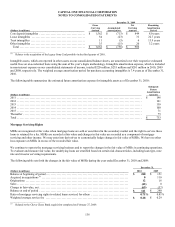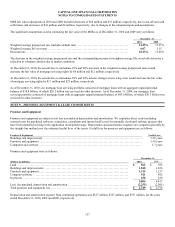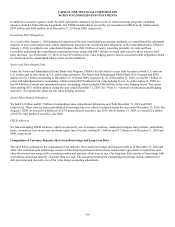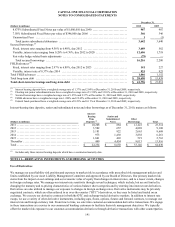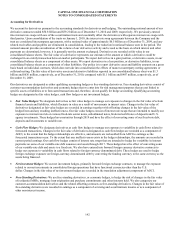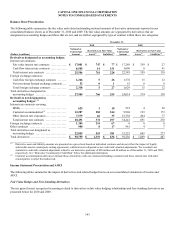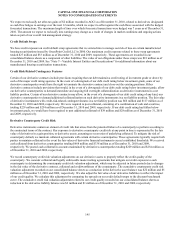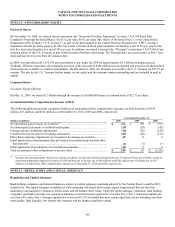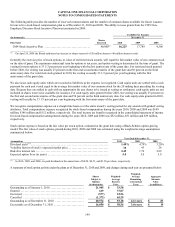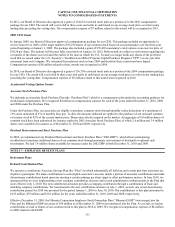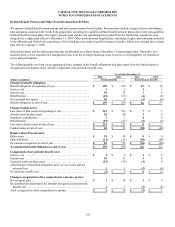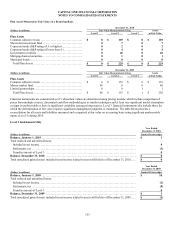Capital One 2010 Annual Report Download - page 165
Download and view the complete annual report
Please find page 165 of the 2010 Capital One annual report below. You can navigate through the pages in the report by either clicking on the pages listed below, or by using the keyword search tool below to find specific information within the annual report.CAPITAL ONE FINANCIAL CORPORATION
NOTES TO CONSOLIDATED STATEMENTS
145
We expect to reclassify net after-tax gains of $2 million recorded in AOCI as of December 31, 2010, related to derivatives designated
as cash flow hedges to earnings over the next 12 months, which we expect to offset against the cash flows associated with the hedged
forecasted transactions. The maximum length of time over which forecasted transactions were hedged was 7 years as of December 31,
2010. The amount we expect to reclassify into earnings may change as a result of changes in market conditions and ongoing actions
taken as part of our overall risk management strategy.
Credit Default Swaps
We have credit exposure on credit default swap agreements that we entered into to manage our risk of loss on certain manufactured
housing securitizations issued by GreenPoint Credit LLC in 2000. Our maximum credit exposure related to these swap agreements
totaled $27 million and $33 million as of December 31, 2010 and 2009, respectively. These agreements are recorded in our
consolidated balance sheets as a component of other liabilities. The value of our obligations under these swaps was $18 million as of
December 31, 2010 and 2009. See “Note 7—Variable Interest Entities and Securitizations” for additional information about our
manufactured housing securitization transactions.
Credit Risk-Related Contingency Features
Certain of our derivative contracts include provisions requiring that our debt maintain a credit rating of investment grade or above by
each of the major credit rating agencies. In the event of a downgrade of our debt credit rating below investment grade, some of our
derivative counterparties would have the right to terminate the derivative contract and close-out the existing positions. Other
derivative contracts include provisions that would, in the event of a downgrade of our debt credit rating below investment grade, allow
our derivative counterparties to demand immediate and ongoing full overnight collateralization on derivative instruments in a net
liability position. Certain of our derivative contracts may allow, in the event of a downgrade of our debt credit rating of any kind, our
derivative counterparties to demand additional collateralization on such derivative instruments in a net liability position. The fair value
of derivative instruments with credit-risk-related contingent features in a net liability position was $66 million and $117 million as of
December 31, 2010 and 2009, respectively. We were required to post collateral, consisting of a combination of cash and securities,
totaling $229 million and $254 million as of December 31, 2010 and 2009, respectively. If our debt credit rating had fallen below
investment grade, we would have been required to post additional collateral of $39 million and $28 million as of December 31, 2010
and 2009, respectively.
Derivative Counterparty Credit Risk
Derivative instruments contain an element of credit risk that arises from the potential failure of a counterparty to perform according to
the contractual terms of the contract. Our exposure to derivative counterparty credit risk at any point in time is represented by the fair
value of derivatives in a gain position, or derivative assets, assuming no recoveries of underlying collateral. To mitigate the risk of
counterparty default, we maintain collateral agreements with certain derivative counterparties. These agreements typically require both
parties to maintain collateral in the event the fair values of derivative financial instruments exceed established thresholds. We received
cash collateral from derivatives counterparties totaling $668 million and $338 million as of December 31, 2010 and 2009,
respectively. We posted cash collateral in accounts maintained by derivatives counterparties totaling $229 million and $254 million as
of December 31, 2010 and 2009, respectively.
We record counterparty credit risk valuation adjustments on our derivative assets to properly reflect the credit quality of the
counterparty. We consider collateral and legally enforceable master netting agreements that mitigate our credit exposure to each
counterparty in determining the counterparty credit risk valuation adjustment, which may be adjusted in future periods due to changes
in the fair value of the derivative contract, collateral and creditworthiness of the counterparty. The cumulative counterparty credit risk
valuation adjustment recorded on our consolidated balance sheets as a reduction in the derivative asset balance was $22 million and $5
million as of December 31, 2010 and 2009, respectively. We also adjust the fair value of our derivative liabilities to reflect the impact
of our credit quality. We calculate this adjustment by comparing the spreads on our credit default swaps to the discount benchmark
curve. The cumulative credit risk valuation adjustment related to our credit quality recorded on our consolidated balance sheets as
reduction in the derivative liability balance was $2 million and $1 million as of December 31, 2010 and 2009, respectively.



